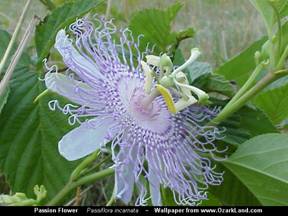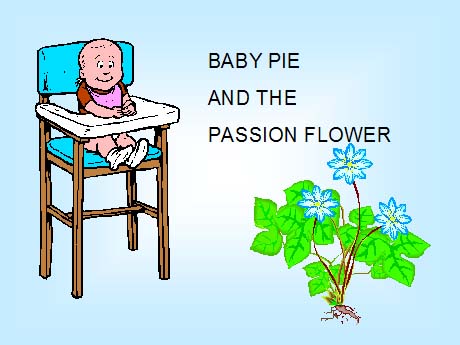Plant Study
My plant study is on the Passion Flower.
Passion Flower
Family: Passion flower
Family: Passifloraceae
Latin Name: Passiflora incarnata
Common Names:
American Maypop, Passion Vine, Apricot Vine, Carkifelek, Charkhi Felek, Maypop, Maypop Passionflower, Passion Flower, Passionflower, Purple Passion-flower, Purple Passionflower, Saa'T Gulu, Ward Assa'Ah, Zahril Aalaam, Granadilla, Purple Passionflower iIne, Red-flowered Poka, Water Lemon, May Pops, Wild Passion Flower.
Related Species: They are believed to be related to the Caricaceae, the Papaya Family.
_______________________________________________________________________
Body System Affiliations:
1. Nervous System
2. Muscular System
________________________________________________________________________
Botanical Description:
Habit: Herbaceous vine. It is Perennial
Size: To 25 feet.
Arrangement: Alternate.
Leaves: Individual leaves are divided into 3 lobes that arise from a common point (palmately lobed). Leaves are approximately 2 1/2 to 5 1/2 inches long and wide and occur on petioles. (1: On-Line).
Flowers: Blue, purple, red, or white flowers.
Each flower has petals varying in color from white to pale red. Inside the petals are wreaths that form rays and surround the axis of the flower (2: On-Line).
“The calyx is of 5 sepals united at the base to form a cup. And usually have the color of the petals at least on their inner surface. The 5 petals are inserted on the calyx throat, which is a complex, double or triple filamentous crown.”
The filaments of the 5 stamens are united to form a tubular sheath for the long-talked ovary, upon which are the 3 club shaped styles. The anthers are large and fixed by their middle (3: On-Line).
Fruit: The ovoid fruit, 1-1/2 to 3 inches wide, has a tough rind that is smooth and waxy and ranging in hue from dark purple with faint, fine white specks, to light yellow or pumpkin-color. Inside is a cavity filled with an aromatic mass of double walled, membranous sacs containing orange-colored, pulpy juice and as many as 250 small, hard, dark brown or black, pitted seeds. The unique flavor is appealing, musky, guava-like and sweet/tart to tart. (4: On-Line).
Underground Parts: Rhizome
_______________________________________________________________________
Ecology:
Habitat: Thickets, disturbed areas, unmowed pastures, roadsides and railroads. Well drained soil. It thrives in areas with lots of available sunlight.(5:323).
Range: Tropical America, Asia and Australia. (6:171).
Native Where: The eastern United States. (7:244).
The plant is indigenous to an area from the southeast U.S. to Argentina and Brazil(8: On-Line).
________________________________________________________________________
Food: Fruits are pulped for jam and desserts. (6:323).
Medicine:
Part Used: Part Used: Vine, Leaves, Stem
The whole or cut dried herb and the fresh or dried aerial parts of Passiflora incarnate (8: On-Line).
Medicinal Actions: Antispasmodic(8: On-Line) Anodyne, anti-inflammatory, antispasmodic, diaphoretic, hypnotic, hypotensive, nervine, sedative (9: On-Line).
Actions: Relaxes muscle spasms,
Sedative, anti-inflammatory, lowers blood pressure (6:323).
Indications: Nervousness and insomnia (8: On-Line). The sedative effect of Passion flower has made it popular for treating a variety of ailments, including nervousness and insomnia. Research had indicated that passion flower has a complex activity on the central nervous system (CNS), which is responsible for its overall tranquilizing effects. Also, it apparently has an antispasmodic effect on smooth muscles within the body, including the digestive system, promoting digestion (8: On-Line).
Body System Associations:
Nervous system.
Muscular system.
Actions:
Anti-anxiety:
Passion flower has a tranquilizing effect, including mild sedative and anti-anxiety effects. In studies conducted since the 1930's, its mode of action has been found to be different than that of most sedative drugs (sleeping pills), thus making it a non-addictive herb to promote relaxation.
Applications: Tea, infusion, tincture.
Preparation:
Infusion-- Pour 150 ml of hot water over 1 teaspoon drug and strain after 10 minutes. To make a rinse for the external treatment of hemorrhoids, put 20 gm drug into 200 ml simmering water, strain and use when cooled.
Tea -- Pour 150 ml of hot water over 1 teaspoon of the herb and strain after 10 minutes.
Pharmacy:
Tincture -- 0.5 to 2 ml, 3 times daily.
Tea-- Drink 2 to 3 times throughout the day and one-half hour before bedtime (8: On-Line).
Cautions: There are no reported side effects for Passion flower and the suggested dosages. However, it is not recommended for use in pregnant women or children under the age of two. If already taking a sedative or tranquilizer, consult a health care professional before using passion flower (8: On-Line).
________________________________________________________________________
Indigenous use:
Food: The Cherokee have eaten the fruit of the Passionflower (10:61).
Medicine:
Indigenous Group: The Cherokee
Part Used: Roots
Indications: Boils, wounds and earaches.
Liver problems and blood tonic (10:61).
Energetics:
Bitter, sedative, cooling Pertaining to the Herb Society of America(6:323).
Preparation: Tea, pour one cup of boiling water over one to two teaspoons of dried passionflower; steep for fifteen to twenty minutes and strain (8: On-Line).
Actions: Tea, infusion (10:61).
________________________________________________________________________
Propagation:
Technique: Seeds, cuttings.
Timing: By seed in spring or semi ripe cuttings in summer (6:323).
________________________________________________________________________
Harvest:
Plant Part: The whole vine is the part used when in flower and many times the fruit will be interspersed in the preparation. This is perfectly acceptable. Some use a part of the root. Many times when harvesting the vine some root will come up with the tug. Of course the leaves are included in the preparation. (3: On-Line).
Season of Harvest: August and September are the usual harvest months.
Method Harvest: Each year before the frost kills it, the entire vine may be cut back to the ground, yielding great quantities of herb. It may be dried in the sun or at a low heat (13: On-Line).
________________________________________________________________________
Personal Experiences:
Medicine:
Part Used: Leaves, stems.
Desired Medicinal Actions: I hoped the plant would produce a calming effect.
Targeted Indications: Nervous System.
Procurement:
Source: Radiance, Herbs and Massage.
Condition: Dried.
Other Procurement Information: None found.
Application/Preparation/Pharmacy:
Applications: Tea.
Preparation: Put two tablespoons of dried herb into mesh tea ball. Boiled water and let tea steep in cup of boiled water for about five minutes.
Pharmacy: One cup every two hours over a six hour time frame. Total of 3 cups of tea.
Purpose: To relax and feel calmed.
Experience: Did not notice any effect. No change in nervous system or muscular system that was noticeable. It is a pleasant tea to drink though.
Cautions: There are no reported side effects for Passion flower and the suggested dosages. However, it is not recommended for use in pregnant women or children under the age of two. If already taking a sedative or tranquilizer, consult a health care professional before using passion flower (8: On Line).
History: Passiflora is derived from Latin and means passion and flower. The Latin species name incarnata means flesh colored and alludes to part of the flower. (14:on-line).
Spanish missionaries in S America regarded these flowers as symbols of Christ’s passion- the three stigmas representing the nails, the five anthers the wounds, and the ten sepals the apostles (Peter and Judas Iscariot being absent) (6:323).
This beautiful flower, called by the early Spaniards the Passion Flower [sic], and by our own pioneers the May-Pop and Wild Apricot, was abundant all over Tennessee. The Cherokee Indians called it the Ocoee; hence the Ocoee valley and river; and they prized it as their most abundant and beautiful of all flowers. It is, therefore, most fitting that this flower be adopted as the State Flower. In 1973 the 88th General Assembly of Tennessee, by Chapter 16, designated the passionflower the state wildflower and the iris the state cultivated flower (15: On-Line).
OCOEE
"Oco-ee, Oco-ee, Oco-ee,"
The Indian maiden sang.
"Oco-ee, Oco-ee, Oco-ee,"
The echoing mountains rang:
"Give me thy blooms, Oco-ee,
Give me thy flowers rare,
Thy twilight blue of sunset hue
To bind my mourning hair.
Give me thy gems, Oco-ee,
Thy turquoise crown unfold,
Beset with bars of yellow stars
On calyxes of gold.
Oco-ee, once my bridal flower--
(Now widowed, thou shalt be,)
my warrior comes not home again,
He comes not home to me,
Oco-ee."
"Oco-ee, Oco-ee, Oco-ee,
'Twas here he won my love,
Your flowers were my bridal bed
Blue as the skies above
Blue as the skies above
But oh, alas! he lies
Unburied in an unknown land
Beneath its unknown skies.
Thy gems are tears, Oco-ee,
(Ay, yellow tear forlorn!)
Thy blue is turned to ruth and rue
Thy turquoise crown is thorn.
Farewell, my land, my life, my love,
Farewell, oh flower of woe,
my warrior comes not home to me
But I to him will go,
Oco-ee."
John Trotwood Moore,
State Librarian and Archivist (15).


Marlene Leyva
Art, Environment and the Child
Winter Quarter
2006
1. Virginia Tech Weed Identification Guide Online at
.http://www.ppws.vt.edu/scott/weed_id/paqin.htm://www.ppws.vt.edu/scott/weed_id/paqin.htm
2. University of Maryland Medical Center 2004 Online at http://www.umm.edu/altmed/ConsHerbs/Passionflowerch.html#Description
3.Blue Boy Herb Company Online at
http://www.blueboyherbs.com/index.htm
4. Copyright 1996, California Rare Fruit Growers, Inc. Online at
http://www.crfg.org/pubs/ff/passionfruit.html
5. Wikimedia Foundation, Inc. Online at
http://en.wikipedia.org/wiki/Passiflora_incarnata
6. The Herb Society of America Encyclopedia of Herbs & There Uses, Dorling Kindersley Publishing, Edited By Deni Brown, 1995.
7. Clark, Jennifer, Harper, Catherine, Balakrishnan, Vilasini. The Illustrated A to Z Encyclopedia of Garden Plants. Alexandria, Virginia, Time Life Books, 2001.
8. Saw Palmetto Harvesting Company, Online at
http://www.passionflower.org/
9. Divine Farmer Herbals, Online at
http://www.divinefarmer.com/h_t_manual/passionfl.html
10. Secrets of Native American Herbal Remedies, Penguin Putnam Inc., Anthony Cichoke, 2001.
11. Picture, Ecology, systematics, and evolution of passion vines (Passifloraceae), L.E. Gilbert, Online at, http://uts.cc.utexas.edu/%7Egilbert/research/passionvines/
12. Crescent Bloom, Online at,
http://www.crescentbloom.com/Plants/Specimen/PA/Passiflora%20incarnata.htm
13. The Vaults of Erowid, Online at,
http://www.erowid.org/psychoactives/cultivation/cultivation_growing-the-hallucinogens.shtml#PASSIONFLOWER
14. University of Florida, Online at,
http://edis.ifas.ufl.edu/FW030
15. Tennessee State Wildflower, Online at,
http://www.netstate.com/states/symb/wildflowers/tn_passionflower.htm
16.Drawing, Passiflora Online at,
http://www.passionflow.co.uk/art3111.htm, ,
Marlene Leyva
Art, Environment and the Child
Winter Quarter
2006

See presentation page for "KID FRIENDLY" version of Passion flower study.